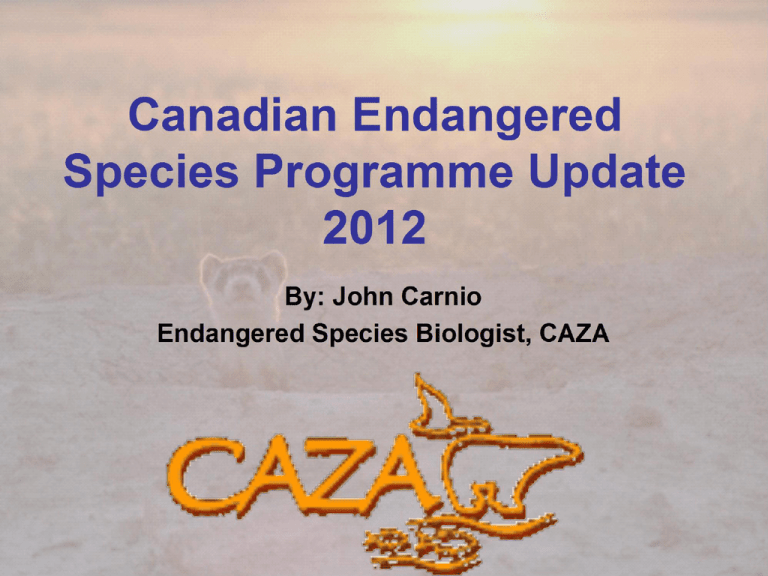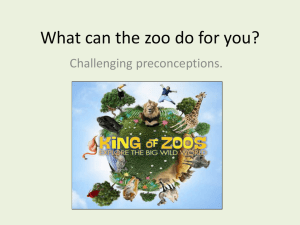
CESP – Canadian Endangered Species Plan:
•A category that involves only Canadian
Endangered Species and whose goal is to
participate in in-situ conservation either through
captive breeding or with educational displays.
TO-DATE:
Whooping Crane
Oregon spotted frog
Black-footed ferret
Burrowing Owl
Loggerhead Shrike
Spotted Owl
Vancouver Island Marmot
WHOOPING CRANE
•Robert Peel and Dr. Sandy Black (Calgary
Zoo) are the representatives on this recovery
effort.
•The Calgary Zoo has been involved in
Whooping Crane breeding since the early
1990’s when they joined the International
Crane Foundation (Baraboo, Wisconsin) and
the Patuxent Wildlife Research Centre
(Maryland).
Whooping Crane Calgary Report:
2012 Whooping crane update
Calgary
New staff training in AI was
implemented this year and two
young crane pairs and a young male
were used.
There are seven Whooping Crane
breeding pairs housed at DWCC,
13 eggs in total were laid of which
5 were fertile.
Three fertile eggs were sent to
Patuxtent Wildlife Research Center;
2 fledged and were sent to
Louisiana for release.
2 eggs sent to International Crane
Foundation; 1 fledged will be used
for release.
•WILD:
•Flock sizes for fall (2011) are estimated at:
•279 for the Aransas-Wood Buffalo
population (AWBP),
•115 for the WI to FL flock,
•20 non migratory birds in Florida, and
24 in Louisiana.
•With 162 cranes in captivity,
•the total of whooping cranes ~ 600.
OREGON SPOTTED FROG
•This species occurs only in four BC
wetlands.
•Dennis Thoney PhD of the Vancouver
Aquarium is the CAZA representative on
this recovery effort.
•Other partners are, the Greater
Vancouver Zoo, Toronto Zoo and
Mountain View Cons. Ctre.
Oregon Spotted Frog
•The release programme involves
•In spring 2011, the captive
capturing tadpoles in the wild and
rearing them until they evolve into frogs population produced over 9000 eggs.
•Three thousand tadpoles were
and then releasing them back into the
released
wild. In 2009 a number of frogs were
•Six hundred frogs were held
retained to start an assurance
back for research
population.
• Fifty tadpoles were retained to
•OSF were bred in captivity (VA) for the
produce F2 generation.
first time in 2010
•2012:
no breeding in Toronto; no report from Vancouver Aquarium as of Sept.27/12
Black-Footed Ferret
• Marie Franke of the Toronto Zoo is the
CAZA CCP representative for this species
initiative
•In 1992, the Toronto Zoo became the only
Canadian facility breeding the black-footed ferret.
In 2003 Canadian recovery team was established.
In 2004 Calgary Zoo joined the BFF Recovery
effort and has been instrumental in doing the field
research necessary for a Canadian release.
•On October 2nd 2009, 34 ferrets were
released into 8 prairie dog colonies in
Grasslands National Park and adjacent lands.
Post-release spotlighting surveys confirmed
that 12 (35%) ferrets survived their first
winter and that there were at least two
lactating females and 3 kits.
•First Canadian black-footed
ferrets born in the wild,
2010.
Return of the Black-footed Ferret to Canada
•2010 saw the evidence of plague on the
grassland and affected the 2010 releases.
•In 2011 there were a lot of prairie dog
young , which is a good sign that plague
was under control.
•A third release of about 40 ferrets took
place in October 2011
2012:
•Surveyors confirmed 3 litters of kits.
•One of the litters was from a 2011 wild
born kit.
•A ferret was seen on a non-release colony,
demonstrating that there is natural
dispersal occurring.
•2012 update continued
•Results of 10 nights of monitoring (Aug
28 to Sept 9, 2012) is 12 minimum
number alive.
•This includes 6 adults (1 male: 5
females), 5 wild born kits,
• One of the ferrets released in the
first year was not seen/trapped until
this year
•Some of the dog towns look good but
some not so good –
• Prairie dog work will continue as
well as dusting the colonies.
•In 2013 Toronto and Calgary will take
part in a Grasslands prairie dog oral
vaccine research project.
•
• 11 BFF (6.5) are scheduled for release
into 4 locations in Grasslands this
Sept./Oct. 2012.
Burrowing Owl Athene cunicularia
. This has been an ongoing recovery effort that has
involved the Burrowing Owl Conservation Society
(BOCS), the British Columbia Wildlife Park (Paul
Williams, Rep) and more recently the Calgary Zoo.
•This year was a good year for the Burrowing Owl
captive recovery programme. The captive
population, 15 pairs produced 89 surviving young.
Only 4 deaths.
•Sixteen young were recruited from the wild (USA),
of which 15 survived.
•Also, in 2012, 65 of the young born in 2011 were
released to the wild.
•The current captive population consist of 161 birds;
37 males, 20 females and 104 of unknown sex.
Comments:
B.C. burrowing owl recovery
efforts began in 1992 with the goal
of re-establishing a population in
the Thompson-Nicola Valley
Kamloops/Merritt region). Since
that time over 1,244 captive bred
owls have been released and over
700 artificial burrows have been
established.
2012 Wild population: Approx.
130 wild born young in Nicola
Valley and 30 wild born young in
South Oakanagan were processed
and banded
the Calgary Zoo’s Centre for
Conservation Research (CCR) will
be assisting in field work and
conducting research to:
1) assess the habitat
characteristics of the artificial
burrows to maximize survival
and reproductive success and
2) refine population recovery
and management strategies.
•Pictures courtesy of BOCS
Eastern Loggerhead Shrike
Recovery Program
•PARTICIPANTS:
•Can. Wildlife Service
•Wildlife Preservation Trust Canada
•CAZA, Zoos (Toronto Zoo and African
Lion Safari)
•Private Landowners
NEW GOALS:
•The captive breeding population will need to be at 80
birds min. in order to achieve the new goals of 90%
genetic diversity over a 10-15 yr. period.
2012 Births & Releases
This has been a good year for the
Loggerhead Shrike captive breeding
programme
Total: 77 chicks born in captivity,
Overall:
15 captive deaths (9young) and
54 young released to the wild
5 wild born young were
recruited into the captive
population.
70 (33.34.3) birds remain in
captive pop.
Will need to recruit 10+ young
to reach our goal of ~80
Field cages for breeding and release.
•Currently we have spaces for 103
birds.
•Next year we have the possibility
of having up to 32 pairs for
breeding.
Spotted Owls
•In 2007 the Spotted Owl Captive
breeding program was started and
is coordinated by Ian Blackburn of
the B,C. Ministry of Environment.
.
The captive population
now includes 20 birds (in Canada
and the United States). All of the
Canadian birds are at Mountain
View Conservation Ctre. Langley
•We presently have the possibility of
having 14 founders in the population
but only 6 have bred so far.
•Picture by J. Hobbs
2012
•This year the Spotted Owl
captive breeding programme
had four births but only one
was viable.
• Four deaths occurred this
year; three to newly hatched
young and one to a juvenile
obtained from the wild that
had a head injury (did not
survive).
•Overall the captive
population increased by one to
20 .
•From this year’s population we will be able to have 8
pairs of potential breeders
Vancouver Island
Marmot
Listed as endangered in
1978
Recovery Team established in 1988
The Vancouver Island Marmot (Marmota
vancouverensis). is a large social rodent (5-7 kg),, and
a true hibernator .
With less than 500 animals left in the world it has the
distinction of being North America’s most endangered
mammal species.
Institutions involved: Toronto Zoo, Calgary Zoo, Mountain View
Conservation & Breeding Centre, TBMWMRC
96w
Wild and Captive VIM Inventory
Unknown
Females
Males
?
98w
99
Wild
2001w 2002 2004w 2005 2007w 2009 2010w
•Wild Pop: >350 ; Captive Pop: 94 (87% less than 2011)
•Update (September 2012):
•This has been another good year for the Vancouver
Island Marmot (VIM) captive breeding programme.
•This is the first breeding season without the full
breeding capacity of the Mount Washington facility.
As such, there were a lot fewer births than previous
years.
•From July 15, 2011 to July 15, 2012, the captive
population had 22 live births, 7 deaths and 66
releases;
•. July 2012 we had 124 (49.51.24) captive marmots.
Of these 32 (15.17) adults and juveniles were released
after July of this year.
•Approximately 17 of the young born this year will be
available for release next year. That will leave us with
a potential breeding population of 75 (34.34.07) for
2013.
To date, a total of 515 pups have been weaned and 406 marmots released back to the wild
Field Updates for Releases and Wild Births
Releases:
15 captive bred marmots released to Mt Washington (for further testing of over
wintering on Mt Wash.)
17 captive bred released (in the normal fashion)
Translocations:
5 marmots from 2011 releases to Mt Washington (survived 1 winter in the wild)
8 wild marmots (7 yearlings and one 2yr old) were processed and translocated
Wild pups:
Butler Mt - 2 litters (6 pups)
Big Ugly - 1 litter (3 pups)
Heather Mtn - 1 litter (4 pups)
Haley - 4-5 litters (14-18 pups)
Green Mtn - 1 litter (5 pups)
Moriarty Mtn - 5 litters (12 pups)
Mt Hooper - 1 litter (4 pups)
North Hooper - 1 litter - (2 pups)
Douglas Peak - 2 litters (7 pups)
Mt Washington - 4 litters (9 pups)
P Mtn - 1 litter (1 pup)
Mt. McQuillan - 1 litter (1-3pups)
Total : 24-25 litters (67-73 pups)
OTHER Canadian Endangered Species Conservation Efforts
6 Institutions responded:
Zoo Sauvage de Saint-Felicien
inventory of short-eared owl in the lake St-John region
PRINCIPAL PARTICIPANTS: Zoo Sauvage and MRNF
They began the inventory of the Short-eared Owl in the lake St-John
region with the collaboration of the MRNF this summer. Short-eared Owl
(SEO) is declining throughout its range. In Canada the species has the
status of special concern (COSEWIC) and an official status in Quebec.
We wanted to know if:
The species is present in the region
The species reproduces in the region
Aquarium du Québec
The aquarium continues to support the efforts of the Copper redhorse,
Moxotoma hubbsi and its recovery program. The Aquarium and CAZA
did assist COVABAR, for their boat that they do the education programs
from on the Richeleu where this species is found (2008 or9?). The
aquarium also distributes educational materials, and has assisted with the
recovery program for rearing alevins and hope to try again this year with
the Ministry and Fishery station in Balwin;
•Ecomuseum :
•Eastern Spiny Softshell Turtle (Apalone spinifera):
• PRINCIPAL PARTICIPANTS: Ecomuseum zoo,
Granby Zoo
•The aims of this project are to improve the recruitment
within the only known Eastern Spiny Softshell Turtle
population in Quebec. Nests are located and eggs are
collected for artificial incubation. This year, 173 young
turtles were released into the wild after successful
artificial incubation. In the last three years 229
hatchlings were released in the Lake Champlain region
where the species inhabits.
•Western Chorus Frog (Pseudacris triseriata):
• PRINCIPAL PARTICIPANTS: Ecomuseum zoo,
Montréal Biodôme
•The aims of this project are to identify the conditions to
successfully maintain, hibernate and breed a captive
population of the Western Chorus Frog (Pseudacris
triseriata). A captive breeding protocol will be developed
as a conservation tool that can be used for future captive
breeding / reintroduction program.
•Zoo de Granby
•The conservation of the Spiny Softshell Turtle in Quebec
(see above)
• Southern Flying Squirrel (Glaucomys volans) an
endangered species in Quebec?
•The biology of the Southern Flying Squirrel is not studied
as much in Quebec. The Ministère des resources et de la
faune du Québec (MRNF), the Université de Montréal and
the Granby Zoo are working on the species to determine
his conservation status in the province.
•Calgary zoo
•In addition to Burrowing Owl, Vancouver Island marmot
Whooping crane and Black-footed ferret work. They are also involved in:
•Northern Leopard Frog Conservation
•The Calgary Zoo’s Centre for Conservation Research is conducting research in
Southern Alberta, that will help determine to what extent leopard frogs are declining,
identify key habitats, establish rigorous survey methods and determine the amount of
management necessary to secure their future.
•Continued--
Calgary zoo continued:
•Mountain Caribou Conservation
•PRINCIPAL PARTICIPANTS: Parks Canada, Calgary Zoo, The Province of
British Columbia
•Parks Canada, the Province of British Columbia and the Calgary Zoo met in
2012 to discuss a captive propagation program to restore herds of Mountain
caribou that are threatened in the National Parks, in Alberta and in British
Columbia.
•Parks Canada assessed several facilities for captive breeding and concluded that
the Calgary Zoo’s offsite Devonian Wildlife Conservation Centre would be the
best facility to provide this service.
Toronto Zoo
•The Toronto Zoo submitted a list of over 30 projects that contained Canadian
species or habitat content. The following is a summary of this spreadsheet:
•They are involved in, Black-footed ferret, Vancouver Island marmot,
Loggerhead shrike, Oregon spotted frog, as well as:
•Conservation of urban amphibians and reptiles,
• Endangered turtle species in general, wetland restoration and education,
• Trumpeter swan reintroduction.
• Wood bison reproductive research.
• Great Lakes Program: Promote Great Lakes Ecosystem and endangered fishes.
• Polar Bear: support studies on Polar bear health, status and determine the
effects of global change on Polar bear populations in Polar Bear Provincial Park.
• Continued---
• Toronto Zoo continued
•BLANCHARD’S CRICKET FROG -(Acris crepitans blanchardi)
•This study will examine DNA profiles of Blanchard’s cricket frogs across the
present and historic range of live and museum specimens.
•Museum specimens will represent the original Canadian range and frogs
from the United States will determine potential source animals for release on
Pelee Island, Ontario (Recovery Plan Objective).
•The Recovery Plan for the cricket frog has been submitted; its focus is on
renewed field surveys for extant populations and to map habitats
•MASSASAUGA RATTLESNAKE – The Massasauga is listed as a
Threatened species in Canada and is a candidate species for federal listing in
the USA.
•Toronto Zoo is participating in multi-year population surveys of an eastern
Massasauga rattlesnake population in southwest Michigan being conducted as
part of a field conservation project run by the Massasauga Species Survival
Plan (SSP).
•The Zoo holds two public workshops “Living with Wildlife” that features the
Massasauga and other species at risk snakes.
An AZA Husbandry Manual for the care and breeding of these rattlesnakes
was developed for the SSP.
•KARNER BLUE BUTTERFLY - (Lycaeides melissa samuelis)
•In 1991, the last Karner blue was observed in Ontario. It was
declared Extirpated in 2008.
•Toronto Zoo joined the Karner Blue Recovery Team in 1992 to
actively pursue the re-introduction of this species into Ontario.
•A protocol has been developed and produced to rear this species in
captivity.
•Since recovery efforts of the release sites were lagging behind
captive breeding efforts, Toronto Zoo stopped working on the captive
breeding and put more emphasis into the study of the microhabitats of
restored release sites.
•For 2010 the Zoo is working on bringing government officials and
NGO representatives together to further the cause of this species..







